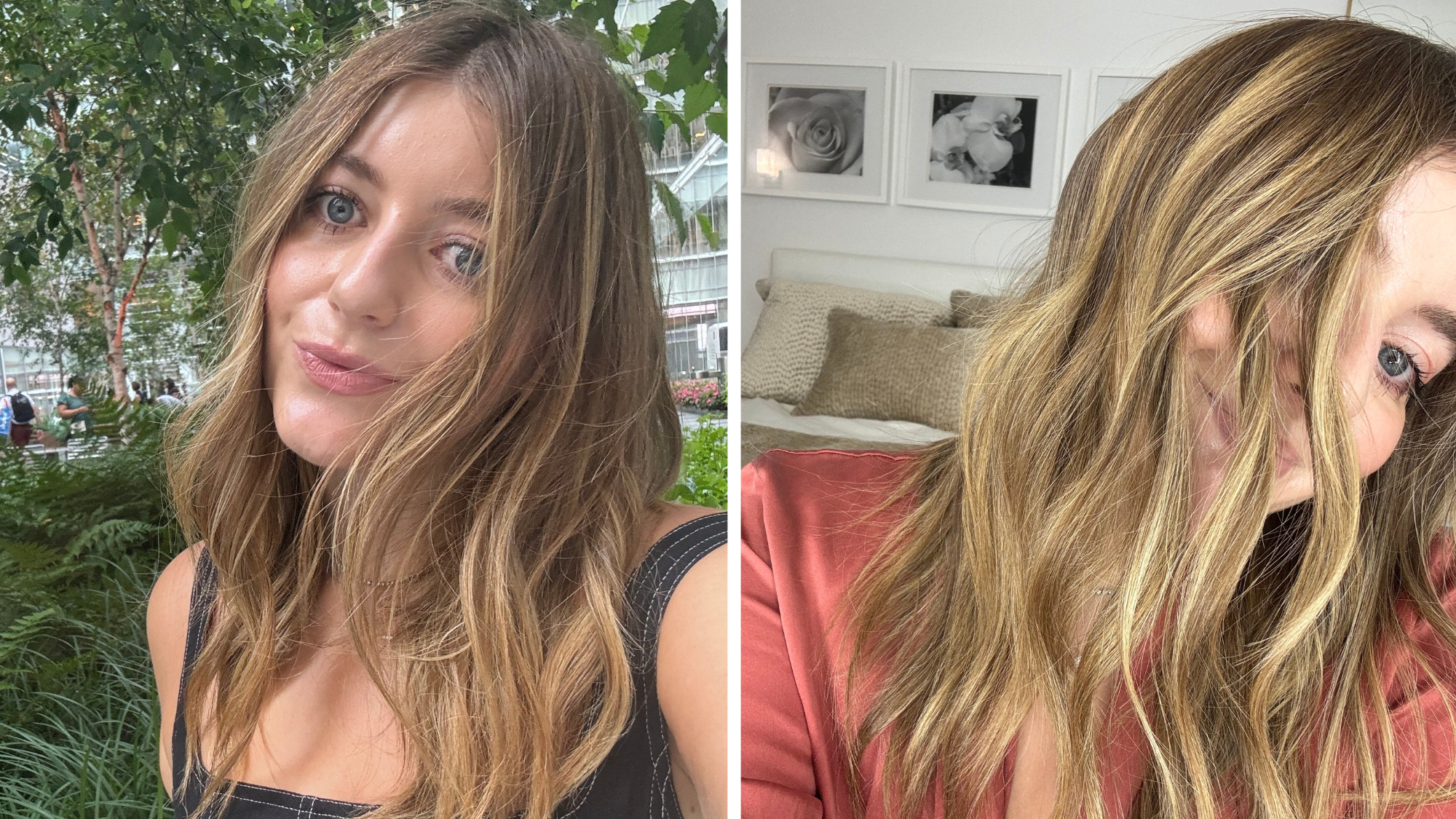
If you have color-treated hair (hi, yes, me), you know that you only have a handful of weeks before your color—blonde or brunette—starts to pick up some unwanted brassy or warm tones. It’s normal. Color oxidizes and changes over time. But that’s precisely why hair toning—at home or in the salon—is necessary for hair color maintenance. The best hair toners and the best hair glosses will help you prolong the time between appointments and effectively provide added shine, brightness, and richness in a pinch.
"Anyone with color-treated hair should be using toners. All hair color fades with time through washing and heat styling," explains Shvonne Perkins, master stylist at Madison Reed. "Hair color is like a bank account. As it gets withdrawn, you need to keep depositing."
For a crash course on what to know about in-salon and at-home hair toner options, keep reading. We’ve spoken to Perkins and celebrity hair colorists Olivia Casanova, Cassie Cohen, and George Papanikolis to get all the information on hair toner.
What Is Hair Toning?
Hair toner is a semi-permanent dye that returns your hair to your desired tone. “Toner either deposits certain pigments onto the hair that cancel out tones you don’t want to see (think of using purple-tinted shampoos to cancel out yellow tones) or to emphasize tones you do want to see (like adding golden champagne tones to blondes for complexity),” explains Perkins.
What Are the Benefits of Hair Toner?
Toners are often used alongside the best hair glosses and glazes, which do exactly as their name suggests: Grant your hair a healthy, straight-from-the-salon finish. “Gloss, glaze, and toner all essentially do the same thing,” Cohen, colorist at Sally Hershberger Salon in New York City, explains. "They can enhance and mute tones while adding shine.”
Some hair toners can also seal the cuticle and temporarily repair split ends, explains Papanikolis.
What Hair Types Can Use Hair Toner?
“Any hair color, any texture, virgin hair, chemically-treated hair, etc., can benefit from using hair toner,” explains Casanova. “If you currently color your hair, then you should especially be getting toned as it helps get rid of any oxidation, which is when color turns yellow or brassy.” But regardless, toning hair (even with a clear gloss) will leave hair shinier and smoother.

What’s the Difference Between Salon Hair Toning and At-Home Hair Toning?
As is true with most treatments, a salon version of an at-home treatment is going to be both more effective and stronger. “The toner you would get in a salon uses developer and has pigments that typically last about 20 shampoos,” explains Papanikolas, noting that salon treatments can help adjust the quality and color of your hair dye. “At-home toner typically comes as a pigmented shampoo or conditioner. These small molecules are usually violet- or blue-based and neutralize unwanted yellow or orange tones. These are more temporary and last about two shampoos.” While at-home versions are not as strong, they are able to extend the life of your hair color.
Will Toning Hair Lighten My Color?
Toners cannot, and should not, replace the lightening process that hair goes through when it's bleached. Glosses and toners won’t actually be able to lighten your hair. In fact, they can only keep hair at the same level or make it darker by depositing additional pigment, explains Papanikolis.
Properly toned colors may appear brighter because they are cooler-toned, not necessarily because they are lighter in shade.
How Often Should I Tone My Hair?
Since toners are semi-permanent, it’s best to get your hair toned in between dye jobs and during the dying process. “Most professional toners last about 20 shampoos so it’s best to go into the salon around every six weeks to get a refresh,” says Papanikolis. “The pigmented shampoos can be started around the two-week mark or when the hair starts changing tones.”
Are There Side Effects to Hair Toner?
Professional toners are pretty nourishing, so you won’t overdo it in terms of frequency. That said, your stylist will want to ensure they set a timer. “If you leave hair color on too long, sometimes it can grab too dark or grab too much of an undesired undertone,” says Casanova.
At-home toners, on the other hand, aren’t right for everyone—and it’s important to pick a solid formula. Cohen explains that many drugstore toning formulas can be overly drying when used incorrectly. If you happen to use too much of the wrong formula, your hair will feel more dry and flaky than shiny. If you leave an at-home hair toning shampoo in for too long, you risk depositing excess pigment (like a purple or blue tint) into your hair.
The Best At-Home Hair Toning Products
This Pureology hair gloss comes in six shades and is named Marie Claire's best hair toner overall. Whether you're trying to neutralize brassiness in blonde hair, bring back ashiness in brunette hair, or warm up red hair, this product has you covered.
"Matrix Brass Off is perfect for maintaining the toners in between highlighting services," says Papanikolas. "It is blue-based and neutralizes any unwanted brassy tones."
Even virgin hair will love using this gloss. It's one of my personal favorites (I use the blonde gloss) and will leave hair with a glass-like shine after just one use. Plus, the formula is incredibly hydrating—I swear it seals my split ends.
This purple shampoo is my saving grace after a day spent in the sun. A few-minute soak instantly removes any orange or yellow undertones, leaving hair in an ashier state.
If purple shampoo isn't your thing, allow me to suggest this daily mist. It's best suited for blondes and will help remove unwanted brassiness and brighten the overall shade of your hair. It also doubles as a heat protectant (you'll be safe from 450 degrees).
Treat this color-correcting foam like any other styling product in your arsenal. A pump or two will not only add volume and bounce to your hair, but it will also neutralize brassiness in dark or brunette hair.
My Hair Toning Review
I’m a fake blonde. There, I said it. I’ve been doing balayage to my naturally brown hair for the greater part of a decade. That said, I’m incredibly loyal to my hair colorist, who lives in my home state of Pennsylvania. Traveling for color appointments doesn’t happen as much as I’d like, so I do everything in my human power to prolong the quality and shine of a single dye job.
At-home hair toners are a regular part of my routine—especially in the summer when brassiness is at an all-time high. I typically start them a month after a color appointment and use them every third wash from there on out. I have a handful of favorites (Olaplex and Davines are strong contenders), but Kerastace’s Blonde Absolu line is my personal favorite.
I use a palm-sized amount the delicious-smelling shampoo and works into a nice lather. It’s incredibly foamy and suds coat every inch of my hair pretty instantly. Unlike some other purple shampoos I’ve tried, this one doesn’t sting my eyes or stain my nails. I let the brassy tone-canceling pigments get to work for roughly three minutes before rinsing.

The key (!!) is to follow up with the brand’s conditioner. It’s most likely my number-one favorite hair product of all time. It leaves my hair with an incredibly shine and lightweight feel, which is pretty impossible given my fine texture.
After styling, my blonde has no orange tones and looks balanced and bright with an added boost of shine. But don’t just take my word for it—I have the pictures to prove it.







